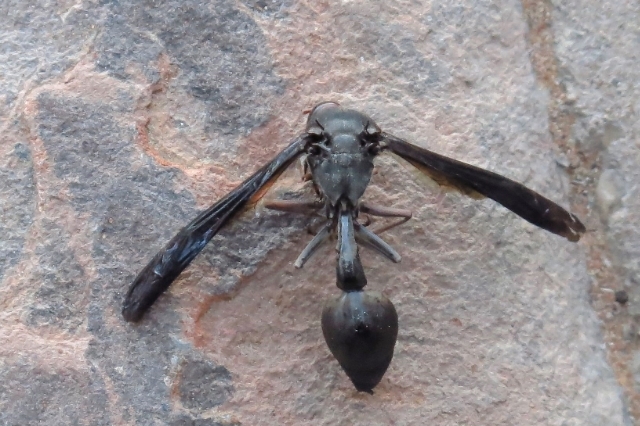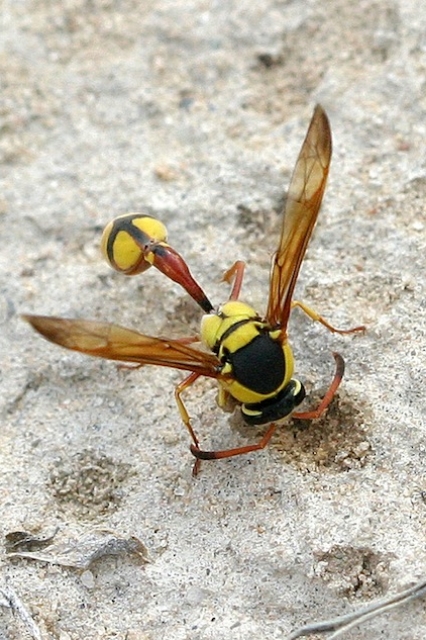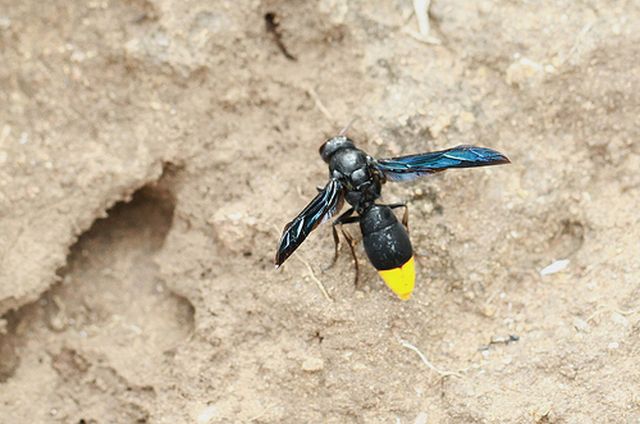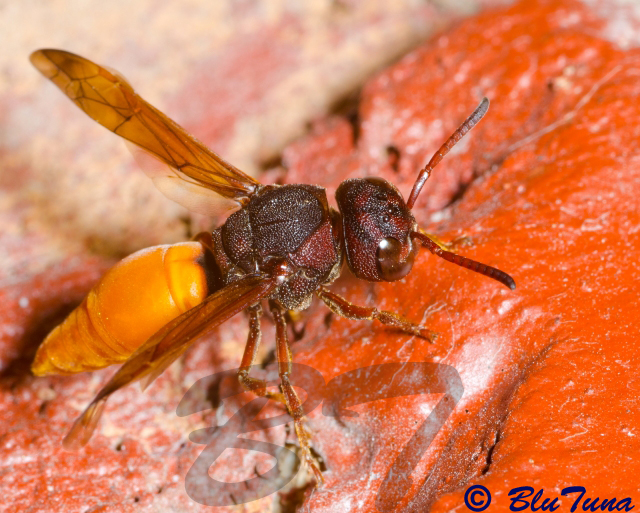Family Vespidae (Paper, Potter & Pollen Wasps)
The family Vespidae are narrow-waisted brown wasps with black, yellow, grey or white markings on the body. Recognizable by fore wings that fold along a longitudinal pleat when at rest, eyes with strongly notched inner margins, and mid tibiae with 2 spurs and simple tarsal claws. Wings clear or dark brown.
Most species build papery multi-celled nests of wood pulp and saliva, attached by stalk to plants, rocks or buildings.
Distribution
Worldwide.
Diversity
The Vepidae are currently represented by four subfamilies in South Africa, including the German hornet Vespula germanica, which was accidentally introduced to Cape Town recently.
Masarinae (Pollen wasps)
Eumeninae (Potter wasps)
Polistinae (Paper wasps)
Vespinae (Hornets)
Biology
Potter or Mason wasps (Eumeninae) nest in holes in the ground, in hollow stems, or construct nests from clay. Females lay an egg in each individual cell and provision the cells with partially paralysed caterpillars. The cell is then sealed. The masarine Pollen wasps provision their nests with pollen and nectar. Paper wasps (Vespinae) are social, constructing communal paper nests. Larvae are fed on chewed-up, soft-bodied insects such as caterpillars.
Links: WaspWeb; Checklist: The Pollen, Paper and Potter Wasps (Hymenoptera: Vespoidea: Vespidae) of Southern Africa
AW Insect Book: Sawflies, Wasps, Bees & Ants (Hymenoptera)
Moderator: Klipspringer
Hymenoptera Vespoidea Vespidae Eumeninae (Potter Wasps)
Subfamily Eumeninae (Potter Wasps or Mason Wasps)
The subfamily Eumeninae are treated as a subfamily of Vespidae. They are mostly slender wasps with short or long waists, very variable in colour, wings clear or brown. As with other Vespidae, fore wings fold along a longitudinal pleat when at rest. The hind wings have an anal lobe. The eyes have strongly notched inner margins.
In the subfamily Eumeninae the tarsal claws are bifid (toothed or forked), there is only one spur on mid tibiae, and the mandibles are very long and cross each other when not in use.
All species are solitary.
Distribution
Worldwide.
Biology
Wide range of nest types: Potter or Mason wasps (Eumeninae) nest in holes in the ground or in hollow stems, or construct nests from clay. Females lay an egg in each individual cell and provision the cells with partially paralysed caterpillars. The cell is then sealed.
Links: WaspWeb
The subfamily Eumeninae are treated as a subfamily of Vespidae. They are mostly slender wasps with short or long waists, very variable in colour, wings clear or brown. As with other Vespidae, fore wings fold along a longitudinal pleat when at rest. The hind wings have an anal lobe. The eyes have strongly notched inner margins.
In the subfamily Eumeninae the tarsal claws are bifid (toothed or forked), there is only one spur on mid tibiae, and the mandibles are very long and cross each other when not in use.
All species are solitary.
Distribution
Worldwide.
Biology
Wide range of nest types: Potter or Mason wasps (Eumeninae) nest in holes in the ground or in hollow stems, or construct nests from clay. Females lay an egg in each individual cell and provision the cells with partially paralysed caterpillars. The cell is then sealed.
Links: WaspWeb
AW Insect Book: Sawflies, Wasps, Bees & Ants (Hymenoptera)
Potter Wasp Afreumenes aethiopicus
Family: Vespidae. Subfamily: Eumeninae
 © BluTuna
© BluTuna
 © BluTuna
© BluTuna
Garden in Johannesburg
Distribution
Afreumenes aethiopicus aethiopicus: Benin, Burkina Faso, Cameroon, Central African Republic, Democratic Republic of Congo, Gabon, Gambia, Ghana, Guinea Bissau, Ivory Coast, Kenya, Liberia, Mali, Niger, Nigeria, Senegal, Sierra Leone, South Africa, Tanzania, Togo, Uganda, Zambia
Afreumenes aethiopicus affinis: Angola, Ethiopia, Kenya, Tanzania
Afreumenes aethiopicus longirostris: Angola, Democratic Republic of Congo, Eritrea, Ethiopia, Kenya, Malawi, Mozambique, South Africa, Tanzania, Yemen, Zambia, Zimbabwe
Afreumenes aethiopicus longitudinalis: Malawi, South Africa, Zimbabwe
Biology
Females build one-celled spherical mud pots resembling urns, with a lip around the entrance, attached to rock faces, buildings or trees. After completion and sealing, no more mud is applied and the lip left intact.
Family: Vespidae. Subfamily: Eumeninae
 © BluTuna
© BluTuna © BluTuna
© BluTunaGarden in Johannesburg
Distribution
Afreumenes aethiopicus aethiopicus: Benin, Burkina Faso, Cameroon, Central African Republic, Democratic Republic of Congo, Gabon, Gambia, Ghana, Guinea Bissau, Ivory Coast, Kenya, Liberia, Mali, Niger, Nigeria, Senegal, Sierra Leone, South Africa, Tanzania, Togo, Uganda, Zambia
Afreumenes aethiopicus affinis: Angola, Ethiopia, Kenya, Tanzania
Afreumenes aethiopicus longirostris: Angola, Democratic Republic of Congo, Eritrea, Ethiopia, Kenya, Malawi, Mozambique, South Africa, Tanzania, Yemen, Zambia, Zimbabwe
Afreumenes aethiopicus longitudinalis: Malawi, South Africa, Zimbabwe
Biology
Females build one-celled spherical mud pots resembling urns, with a lip around the entrance, attached to rock faces, buildings or trees. After completion and sealing, no more mud is applied and the lip left intact.
Hunting cannot be considered a sport as all contestants in a sport should know they are playing the game!
AW Insect Book: Sawflies, Wasps, Bees & Ants (Hymenoptera)
Potter Wasp Delta emarginatum
Family: Vespidae. Subfamily: Eumeninae
 © nan
© nan
Twee Rivieren Camp, Kgalagadi Transfrontier Park
Distribution
Subsaharan Africa and also in the Palaearctic region.
Habitat
Widespread in different vegetation types, commonly seen visiting water and bare patches of ground where it quarries soil.
Biology
Solitary caterpillar-hunting wasp. The female builds a multicelled mud nest, attached to plants, rocks and buildings.
Family: Vespidae. Subfamily: Eumeninae
 © nan
© nanTwee Rivieren Camp, Kgalagadi Transfrontier Park
Distribution
Subsaharan Africa and also in the Palaearctic region.
Habitat
Widespread in different vegetation types, commonly seen visiting water and bare patches of ground where it quarries soil.
Biology
Solitary caterpillar-hunting wasp. The female builds a multicelled mud nest, attached to plants, rocks and buildings.
AW Insect Book: Sawflies, Wasps, Bees & Ants (Hymenoptera)
Potter Wasp Delta lepeleterii
Family: Vespidae. Subfamily: Eumeninae
 © ExFmem
© ExFmem
Female collecting mud for nest, Nossob Walking Trail, Kgalagadi Transfrontier Park (November)
 © BluTuna
© BluTuna
Biology
Mud nest usually built on surfaces of rocks, walls or branches and trunks of trees, either as a single pot or as a group of cells covered by an outer envelope; prey are usually geometrid moth caterpillars
http://www.waspweb.org/Vespoidea/Vespid ... /index.htm
Family: Vespidae. Subfamily: Eumeninae
 © ExFmem
© ExFmemFemale collecting mud for nest, Nossob Walking Trail, Kgalagadi Transfrontier Park (November)
Biology
Mud nest usually built on surfaces of rocks, walls or branches and trunks of trees, either as a single pot or as a group of cells covered by an outer envelope; prey are usually geometrid moth caterpillars
http://www.waspweb.org/Vespoidea/Vespid ... /index.htm
AW Insect Book: Sawflies, Wasps, Bees & Ants (Hymenoptera)
Potter Wasp Synagris sp.
Family: Vespidae. Subfamily: Eumeninae
 © flying cheetah
© flying cheetah
Kruger National Park, Berg n Dal area
Synagris is an afrotropical genus of large potter wasps. Several Synagris wasps are strongly sexually dimorphic and males bear notable morphological secondary sexual traits including metasomal lamellar or angular protruding structures and hornlike or tusklike mandibular and/or clypeal projections.
The few species of Synagris with known biology are also notable for guarding their nests and even attending and feeding their larvae during their development (progressive provisioning), a primitively social behavior unusual among eumenines, which normally practice mass provisioning.
There are 4 subgenera and 28 species currently recognized.
Family: Vespidae. Subfamily: Eumeninae
 © flying cheetah
© flying cheetahKruger National Park, Berg n Dal area
Synagris is an afrotropical genus of large potter wasps. Several Synagris wasps are strongly sexually dimorphic and males bear notable morphological secondary sexual traits including metasomal lamellar or angular protruding structures and hornlike or tusklike mandibular and/or clypeal projections.
The few species of Synagris with known biology are also notable for guarding their nests and even attending and feeding their larvae during their development (progressive provisioning), a primitively social behavior unusual among eumenines, which normally practice mass provisioning.
There are 4 subgenera and 28 species currently recognized.
AW Insect Book: Sawflies, Wasps, Bees & Ants (Hymenoptera)
Potter Wasp Tricarinodynerus guerinii
Family: Vespidae. Subfamily: Eumeninae
 © BluTuna
© BluTuna
 © BluTuna
© BluTuna
Hartebeespoort Dam area, North West Province
Distribution
Angola, Botswana, Burundi, Central African Republic, Democratic Republic of Congo, Eritrea, Ethiopia, Lesotho, Malawi, Mozambique, Namibia, Nigeria, South Africa, Sudan, Tanzania, Zambia, Zimbabwe.
Biology
Nest in pre-existing cavities in vertical banks, or in hollow stems, or empty cells of aerial mud nesters. The entrance has a downwards curved mud turret. An egg is laid within each of several cells, which are sealed after being provisioned with a stung caterpillar (Tortricidae, Gelechiidae, Oecophoridae and Pyralidae)
http://www.waspweb.org/Vespoidea/Vespid ... erinii.htm
Family: Vespidae. Subfamily: Eumeninae
 © BluTuna
© BluTuna © BluTuna
© BluTunaHartebeespoort Dam area, North West Province
Distribution
Angola, Botswana, Burundi, Central African Republic, Democratic Republic of Congo, Eritrea, Ethiopia, Lesotho, Malawi, Mozambique, Namibia, Nigeria, South Africa, Sudan, Tanzania, Zambia, Zimbabwe.
Biology
Nest in pre-existing cavities in vertical banks, or in hollow stems, or empty cells of aerial mud nesters. The entrance has a downwards curved mud turret. An egg is laid within each of several cells, which are sealed after being provisioned with a stung caterpillar (Tortricidae, Gelechiidae, Oecophoridae and Pyralidae)
http://www.waspweb.org/Vespoidea/Vespid ... erinii.htm
Hunting cannot be considered a sport as all contestants in a sport should know they are playing the game!
AW Insect Book: Sawflies, Wasps, Bees & Ants (Hymenoptera)
Potter Wasp
Family: Vespidae. Subfamily: Eumeninae
 © BluTuna
© BluTuna
Garden in Johannesburg
Family: Vespidae. Subfamily: Eumeninae
 © BluTuna
© BluTunaGarden in Johannesburg
AW Insect Book: Sawflies, Wasps, Bees & Ants (Hymenoptera)
Potter Wasp
Family: Vespidae. Subfamily: Eumeninae
 © BluTuna
© BluTuna
 © BluTuna
© BluTuna
Garden in Johannesburg
Family: Vespidae. Subfamily: Eumeninae
 © BluTuna
© BluTuna © BluTuna
© BluTunaGarden in Johannesburg
Hymenoptera Vespoidea Vespidae Polistinae (Paper Wasps)
Subfamily Polistinae (Paper Wasps)
The subfamily Polistinae are common and abundant social wasps, which build paper nests. The Polistinae is the most diverse subfamily of social wasps in terms of both speciosity (species richness) – with about 800 species described to date – morphologies, behaviours and nest architecture.
Polistinae are small to very large wasps, with a declivous or petiolate first metasomal segment.
Generally speaking world-wide, Polistinae are characterised by two major behavioural traits, based on their mode of colony founding and mechanism of reproductive dominance:
• Independent founders: colonies are initiated by one or several inseminated individuals (queens), independently of any workers. The nests are generally simply constructed without an external protective envelope. Soon after nest establishment, one of the founding queens becomes the sole egg layer. Reproductive dominance is maintained by the most aggressive queen. This group is made up of 5 genera: Mischocyttarus, Belonogaster, Parapolybia, Polistes and some Ropalidia.
• Swarm founders: colonies are initiated by a swarm of a large number of workers accompanied by a few queens. It is the workers that select the nesting site while the queen(s) wait until enough cells have been completed. Reproductive dominance in this group appears to involve pheromones. This group is made up of 20 genera of the tribe Epiponini, the genus Polybioides and some Ropalidia.
Distribution
Polistinae are primarily tropical in distribution but can be found world-wide.
To date 29 genera world-wide have been recognised, distributed in 4 tribes: Ropalidiini, Polistini, Mischocyttarini and Epiponini, of which only the first two are found in South Africa.
Biology
Social, constructing communal paper nests usually comprising a single comb (double comb in Polybiodes), which may be arranged vertically or horizontally. The comb is usually exposed, but in Polybioides the comb is enclosed in a thin, brittle paper covering. Larvae are fed on chewed-up, soft-bodied insects such as caterpillars.
New nests are started in spring by a fertilized female who has overwintered in a sheltered position, often together with other mated females. She begins by constructing a strong stalk attached to a branch within a bush, under a rock overhang, or under the eaves of a roof. The stalk and subsequent downward hanging hexagonal cells are made from chewed up plant fibres mixed with saliva, producing a tough papery material that is also very light. The hexagonal cells are added in ever increasing concentric circles away from the central stalk, which is smeared with a dark ant-repellent secretion produced by her abdominal glands. This prevents predatory ants from raiding the nest.
The foundress female lays an egg at the bottom of each cell she has constructed. On hatching the larva is fed pellets of chewed up caterpillars. Once the larva reaches maturity the cell is capped and the larva pupates. On emerging, this first generation of new wasps, which are the foundress female's daughters, assist with nest building and raising their siblings. They are unable to mate as there are no males in the colony at this stage. The ovaries of these workers do not develop and are maintained in this condition by aggressive behaviour exerted towards these individuals by the foundress queen. With some species the foundress queen is joined by other mated females who also lay eggs. Rival females eat each other's eggs until one female achieves dominance.
The worker females are responsible for hunting caterpillars and presenting the chewed up bolus to the larvae in the cells, which then bite off pieces. The larvae regurgitate saliva, which is consumed by the worker female. This transfer of saliva (trophallaxis) provides the worker with essential nutrients such as carbohydrates, proteins and probably also enzymes, that she cannot make herself. Larvae are occasionally given the feeding response by workers or the queen without food presentation to solicit saliva for their own consumption. Returning workers are also sometimes forced to give up their food provision by females higher up the dominance hierarchy. The queen never leaves the nest and is fed by the workers. Nest defense is achieved via very painful stings delivered by the workers. Stings are not barbed and the females can administer venom repeatedly.
The haplo-diploid method of sex determination in Hymenoptera (where unfertilized eggs give rise to males and fertilized eggs to females) means that sisters share 75% of their genes, but only 50% of their genes are shared with their daughters. Hence, a female who helps raise her sisters (some of whom will develop into queens) and does not lay her own eggs contributes to her own reproductive success, since she is getting a greater proportion of her own genes into the next generation (75% of her genes) than if she raised her own off-spring (50% of her genes). This is the basis of Kin selection theory and is thought to be one of the reasons why sociality has evolved so many times within the Hymenoptera, whereas it has only evolved once in the other insects (in the termites).
By autumn the queen has no more sperm left and lays unfertilized eggs, which give rise to males. The colony breaks up and the males disperse to mate with females from other colonies, after which they die. The mated females then go into diapause to overwinter, ready to start new colonies the following spring.
Links: WaspWeb
The subfamily Polistinae are common and abundant social wasps, which build paper nests. The Polistinae is the most diverse subfamily of social wasps in terms of both speciosity (species richness) – with about 800 species described to date – morphologies, behaviours and nest architecture.
Polistinae are small to very large wasps, with a declivous or petiolate first metasomal segment.
Generally speaking world-wide, Polistinae are characterised by two major behavioural traits, based on their mode of colony founding and mechanism of reproductive dominance:
• Independent founders: colonies are initiated by one or several inseminated individuals (queens), independently of any workers. The nests are generally simply constructed without an external protective envelope. Soon after nest establishment, one of the founding queens becomes the sole egg layer. Reproductive dominance is maintained by the most aggressive queen. This group is made up of 5 genera: Mischocyttarus, Belonogaster, Parapolybia, Polistes and some Ropalidia.
• Swarm founders: colonies are initiated by a swarm of a large number of workers accompanied by a few queens. It is the workers that select the nesting site while the queen(s) wait until enough cells have been completed. Reproductive dominance in this group appears to involve pheromones. This group is made up of 20 genera of the tribe Epiponini, the genus Polybioides and some Ropalidia.
Distribution
Polistinae are primarily tropical in distribution but can be found world-wide.
To date 29 genera world-wide have been recognised, distributed in 4 tribes: Ropalidiini, Polistini, Mischocyttarini and Epiponini, of which only the first two are found in South Africa.
Biology
Social, constructing communal paper nests usually comprising a single comb (double comb in Polybiodes), which may be arranged vertically or horizontally. The comb is usually exposed, but in Polybioides the comb is enclosed in a thin, brittle paper covering. Larvae are fed on chewed-up, soft-bodied insects such as caterpillars.
New nests are started in spring by a fertilized female who has overwintered in a sheltered position, often together with other mated females. She begins by constructing a strong stalk attached to a branch within a bush, under a rock overhang, or under the eaves of a roof. The stalk and subsequent downward hanging hexagonal cells are made from chewed up plant fibres mixed with saliva, producing a tough papery material that is also very light. The hexagonal cells are added in ever increasing concentric circles away from the central stalk, which is smeared with a dark ant-repellent secretion produced by her abdominal glands. This prevents predatory ants from raiding the nest.
The foundress female lays an egg at the bottom of each cell she has constructed. On hatching the larva is fed pellets of chewed up caterpillars. Once the larva reaches maturity the cell is capped and the larva pupates. On emerging, this first generation of new wasps, which are the foundress female's daughters, assist with nest building and raising their siblings. They are unable to mate as there are no males in the colony at this stage. The ovaries of these workers do not develop and are maintained in this condition by aggressive behaviour exerted towards these individuals by the foundress queen. With some species the foundress queen is joined by other mated females who also lay eggs. Rival females eat each other's eggs until one female achieves dominance.
The worker females are responsible for hunting caterpillars and presenting the chewed up bolus to the larvae in the cells, which then bite off pieces. The larvae regurgitate saliva, which is consumed by the worker female. This transfer of saliva (trophallaxis) provides the worker with essential nutrients such as carbohydrates, proteins and probably also enzymes, that she cannot make herself. Larvae are occasionally given the feeding response by workers or the queen without food presentation to solicit saliva for their own consumption. Returning workers are also sometimes forced to give up their food provision by females higher up the dominance hierarchy. The queen never leaves the nest and is fed by the workers. Nest defense is achieved via very painful stings delivered by the workers. Stings are not barbed and the females can administer venom repeatedly.
The haplo-diploid method of sex determination in Hymenoptera (where unfertilized eggs give rise to males and fertilized eggs to females) means that sisters share 75% of their genes, but only 50% of their genes are shared with their daughters. Hence, a female who helps raise her sisters (some of whom will develop into queens) and does not lay her own eggs contributes to her own reproductive success, since she is getting a greater proportion of her own genes into the next generation (75% of her genes) than if she raised her own off-spring (50% of her genes). This is the basis of Kin selection theory and is thought to be one of the reasons why sociality has evolved so many times within the Hymenoptera, whereas it has only evolved once in the other insects (in the termites).
By autumn the queen has no more sperm left and lays unfertilized eggs, which give rise to males. The colony breaks up and the males disperse to mate with females from other colonies, after which they die. The mated females then go into diapause to overwinter, ready to start new colonies the following spring.
Links: WaspWeb


